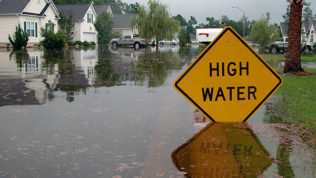You do not have to live in a designated flood zone to be susceptible to flood loss.
Because most standard home insurance policies exclude coverage for surface water that damages property, you may need to obtain coverage through the National Flood Insurance Program. Your professional, independent insurance agent can advise you on the best choice to protect you from the financial loss a flood could bring.
Meanwhile, you can take action to prevent or reduce the impact of flood losses at your home.
Before you are faced with a devastating loss from flood, consider:
- Waterproofing uninhabitable portions of your home to help make them resistant to flood damage.
- Extending your downspouts away from the home, preferably all the way to the drainage system at the edge of your property if they are available and reachable.
- Sealing the home’s exterior walls that are below ground level by using tar, vapor wrap or other protective sheathing; these steps can also protect you from losses caused by hydrostatic water pressure
- Building up landscaping with extra mulch in a downward slope to help direct water away from the home.
- Testing backup generators and sump pumps annually. If you have a battery backup on either, make sure they are charged and ready.
- Installing flood vents in your home to allow flood waters to pass safely.
- Checking the caulking of exterior doors and windows to make sure they are sealed properly.
- Prioritizing the objects in an art collection so that you know in advance which will be removed from the home and which will be stored in the home at a higher elevation.
Be mindful of flood and weather events in the area. During a flood:
- Take important personal possessions and expensive area rugs to the interior of your home and elevate them if possible. Keep them away from windows and doors.
- Remove curtains from windows and doors or consider covering the curtains in plastic to protect them from moisture.
- Place towels at the base of any exterior doors.
- Locate important documents, such as insurance policies, birth certificates, passports, bank account details and credit card information. Put them in a waterproof container.
- Check your drains on terraces or balconies for clogs, so that water can flow away from the home naturally.
- Maintain a current inventory of your home and keep a copy of the inventory off-site, such as in a safe deposit box.
- Cover your car and elevate it, if possible, even if you leave it in your garage.
After a flood, we suggest:
- Contacting a restoration company. If safe to do so, start the air conditioner to begin the process of water evacuation from your home.
- Removing all wet items to one location, such as the garage.
- Starting the conservation of your personal items immediately within a safe working space.
- Calling your agent to discuss any damage.
More information:
Preparation key to protecting home and family from flooding
This loss control information is advisory only. The author assumes no responsibility for management or control of loss control activities. Not all exposures are identified in this article. Contact Landmark Risk Management & Insurance for insurance coverage advice and loss control information.

